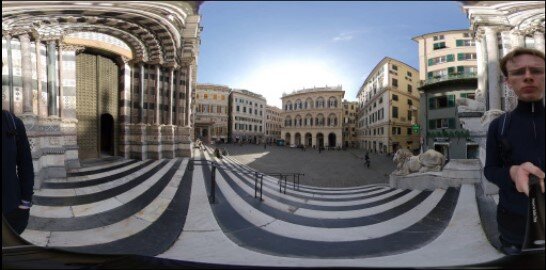Scientists at the University of Bath have developed a quick and easy approach for capturing 360° VR photography without using expensive specialist cameras. The system uses a commercially available 360° camera on a rotating selfie stick to capture video footage and create an immersive VR experience.
Virtual reality headsets are becoming increasingly popular for gaming, and with the global pandemic restricting our ability to travel, this system could also be a cheap and easy way to create virtual tours for tourist destinations.
Conventional 360° photography stitches together thousands of shots as you move around one spot. However, it doesn’t retain depth perception, so the scene is distorted and the images look flat.
Whilst state-of-the-art VR photography, which includes depth perception, is available to professional photographers, it requires expensive equipment, as well as time to process the thousands of photos needed to create a fully immersive VR environment.
Dr. Christian Richardt and his team at CAMERA, the University of Bath’s motion capture research center, have created a new type of 360° VR photography accessible to amateur photographers called OmniPhotos.
This is a fast, easy and robust system that recreates high quality motion parallax, so that as the VR user moves their head, the objects in the foreground move faster than the background.
This mimics how your eyes view the real world, creating a more immersive experience.
OmniPhotos can be captured quickly and easily using a commercially available 360° video camera on a rotating selfie stick.
Using a 360° video camera also unlocks a significantly larger range of head motions.
OmniPhotos are built on an image-based representation, with optical flow and scene adaptive geometry reconstruction, which is tailored for real time 360° VR rendering.
Dr. Richardt and his team presented the new system at the international SIGGRAPH Asia conference on Sunday 13th December 2020.
He said: “Until now, VR photography that uses realistic motion parallax has been the preserve of professional VR photographers, using expensive equipment and requiring complex software and computing power to process the images.
“OmniPhotos simplifies this process so that you can use it with a commercially available 360° camera that only costs a few hundred pounds.
“This opens up VR photography to a whole new set of applications, from estate agent’s virtual tours of houses to immersive VR journeys at remote tourist destinations. With the pandemic stopping many people from traveling on holiday this year, this is a way of virtually visiting places that are currently inaccessible.”
Smile! Photos converted into 3-D from any mobile device
More information:
Tobias Bertel et al. OmniPhotos, ACM Transactions on Graphics (2020). DOI: 10.1145/3414685.3417770
Source Code: github.com/cr333/OmniPhotos
Provided by
University of Bath
Citation:
Creating a realistic VR experience using a normal 360-degree camera (2020, December 14)
retrieved 15 December 2020
from https://techxplore.com/news/2020-12-realistic-vr-degree-camera.html
This document is subject to copyright. Apart from any fair dealing for the purpose of private study or research, no
part may be reproduced without the written permission. The content is provided for information purposes only.



